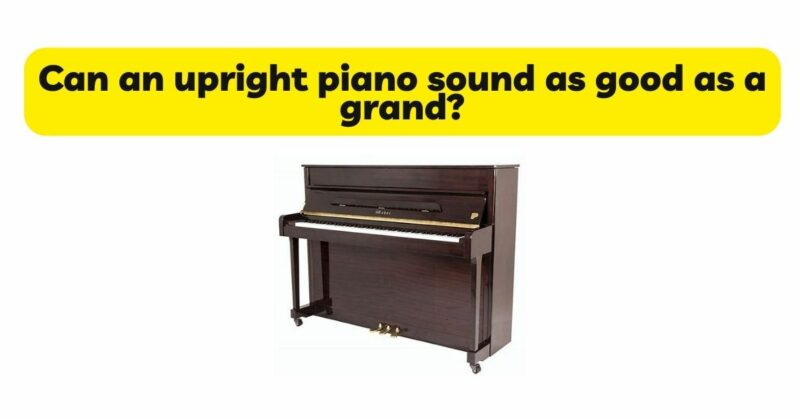When it comes to piano sound quality, grand pianos have long been regarded as the pinnacle of excellence. However, with advancements in design, craftsmanship, and technology, upright pianos have made significant strides in bridging the gap and challenging this perception. In this article, we will explore whether an upright piano can sound as good as a grand piano. By examining factors such as design improvements, tonal range, sound projection, and individual preferences, we aim to provide a comprehensive understanding of the sound capabilities of upright pianos and debunk the notion that only grand pianos can deliver exceptional sound quality.
- Design Improvements: Traditionally, the vertical design of upright pianos posed limitations on their sound quality compared to the horizontal string orientation of grand pianos. However, modern upright pianos have benefited from design improvements that have enhanced their sound production. These include advancements in string scaling, soundboard construction, and materials used. These improvements have resulted in upright pianos capable of producing a more resonant and balanced sound, rivaling that of some grand pianos. It is important to note that the sound quality of an upright piano can vary depending on the specific brand, model, and craftsmanship. Higher-end upright pianos often incorporate design features that maximize their sound potential.
- Tonal Range and Expressiveness: An essential aspect of sound quality is the instrument’s tonal range and expressiveness. Grand pianos are known for their wide tonal palette and ability to produce nuanced and expressive sounds. While upright pianos may have a more limited tonal range due to their vertical string orientation, advancements in design and engineering have expanded the tonal capabilities of modern upright pianos. Manufacturers have incorporated innovations such as duplex scaling, improved hammer design, and soundboard enhancements to achieve greater tonal expressiveness. Some high-quality upright pianos can now produce a broad range of tones, allowing for expressive playing across different musical genres.
- Sound Projection: Sound projection is another factor that contributes to the perception of sound quality in pianos. Grand pianos, with their larger size and horizontal string orientation, are often favored for their superior sound projection capabilities. Upright pianos, on the other hand, may have limitations in sound projection due to their vertical design. However, it is important to consider the context in which the piano will be used. In smaller rooms or intimate settings, the sound projection of an upright piano can be more than sufficient. Additionally, advancements in upright piano design, including improved soundboard area and resonant back construction, have contributed to enhanced sound projection in some models. Consider the intended use and space requirements when assessing the sound projection capabilities of an upright piano.
- Individual Preferences and Musical Context: Sound quality is subjective, and individual preferences play a significant role in assessing whether an upright piano can sound as good as a grand piano. Some musicians and listeners may prefer the warm, intimate, and focused sound of an upright piano, finding it more suitable for certain musical genres and styles. Others may gravitate toward the broader tonal palette and expansive sound of a grand piano. Additionally, the musical context in which the piano will be used should be considered. The sound requirements for a professional concert pianist may differ from those of a casual player or someone playing in a small ensemble. It is important to evaluate the sound quality of an upright piano within the specific musical context and personal preferences of the pianist.
- Price Considerations: Price is often a determining factor in piano selection. Grand pianos, especially high-quality instruments, tend to be more expensive than upright pianos. While grand pianos offer an exceptional sound experience, they may be financially out of reach for many individuals. Upright pianos, on the other hand, provide a more accessible option for those seeking quality sound at a lower price point. It is crucial to consider the trade-offs between sound quality and budget constraints when making a purchasing decision. High-end upright pianos can offer remarkable sound quality at a more affordable price compared to some grand pianos.
Conclusion: The notion that only grand pianos can deliver exceptional sound quality is being challenged by the advancements in upright piano design, craftsmanship, and technology. Modern upright pianos have made significant progress in bridging the gap between their sound capabilities and those of grand pianos. Design improvements, expanded tonal range, enhanced sound projection, and individual preferences all contribute to the sound quality of an upright piano. While grand pianos may still be favored by some musicians for their wide tonal palette and sound projection, high-quality upright pianos can produce a rich, expressive, and balanced sound that rivals that of some grand pianos. Ultimately, the sound quality of a piano is subjective and depends on individual preferences, musical context, and budget considerations. It is essential to evaluate the specific brand, model, craftsmanship, and personal preferences when assessing whether an upright piano can sound as good as a grand piano.


